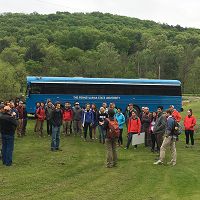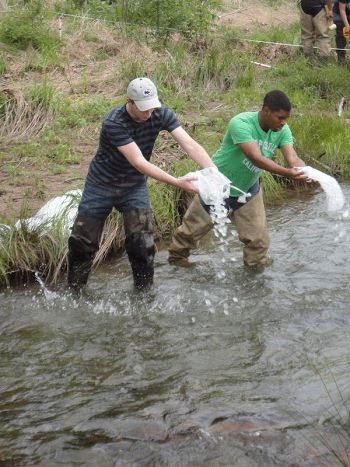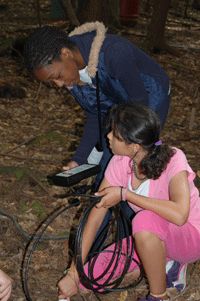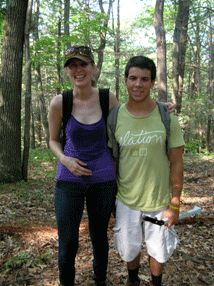EDUCATION-OUTREACH
Outreach opportunities at Shale Hills range from pre high-school freshmen to international post-doctoral scholars. During each event, participants are engaged in field techniques, data collection, and learn applications to create predictive models. An increased understanding of past and present processes occurning in our catchment provide opportunity to up-scale and test models for larger watersheds as well as provide parameters for future casting.
Shale Satellite Sites
Ashlee Dere (PSU) and Sarah Lemon (Colgate University) collect soil samples at 10 cm intervals from the New York transect satellite site, near Paris, New York, in Oneida County.
International Student Experience
Lin Ma (Geoscience, Penn State) measured U disequilibrium isotopes on Shale Hills samples at the Univ of Strasbourg with Francois Chabaux. Beth Herndon (Geosciences, Penn State) learned to run mesocosm experiments at Univ of Sheffield. Jennifer Williams and Ashlee Dere (Geoscience, Penn State) visited Plynlimon, Wales, a shale site that will become part of our satellite sites. During their UK visit, Jennifer and Ashlee were hosted by the British Geological Survey, and encouraged to explore the records room and observe some of Charles Darwin's notebooks.
George Holmes (MS CEE Dept. Penn State) participation in the International CZO Experience started in Vienna, Austria with two weeks visiting scientists at the IAEA (International Atomic Energy Agency). The first week was spent at a short course demonstrating how to operate a Los Gatos Research Liquid Water Stable Isotope Analyzer. The second week was spent working with Brent Newman on the GNIR (Global Network of Isotopes in Rivers) database. The database was made public this year and Brent is encouraging publishing papers using the data. He also spent time with Tomas Vitvar and Luis Araguas concerning the Shale Hills CZO. The next three weeks were spent in Zurich, Switzerland working with Manfred Staehli at WSL (Swiss Federal Institute for Forest, Snow and Landscape Research). While visiting, he was able to talk with many scientists about the Shale Hills CZO and discuss related projects like the BigLink Damma Glacial Forefield and the Cottbus Watershed in Germany. At WSL he gave a presentation that outlined all three CZO projects with focus on Shale Hills. He was able to visit the Damma Glacier Forefield and see the set up of the instrumentation and travel to the Rietholzbach research catchment. The final week was spent in Davos, Switzerland at the Goldschmidt Conference with many talks related to the Shale Hills CZO.
George Holmes (MS CEE Dept. Penn State) participated in the International CZO Experience, which started in Vienna, Austria with two weeks visiting scientists at the IAEA (International Atomic Energy Agency). The first week was spent at a short course demonstrating how to operate a Los Gatos Research Liquid Water Stable Isotope Analyzer. The second week was spent working with Brent Newman on the GNIR (Global Network of Isotopes in Rivers) database.
Bryn Kimball (Geosciences, Penn State) visited Stockholm University, the Royal Institute of Technology (RIT) in Stockholm, Sweden and the University of Sheffield, UK to share and learn of recent research projects focused on mineral dissolution rates. Discussions of chalcopyrite dissolution rates and variability by orders of magnitude helped to further her understanding of rock dissolutions and what minerals likely contribute the most elemental release. A formal presentation of Bryn's chalcopyrite dissolution project was delivered to Dr. Malmstrom (RIT) and Dr. Wold (RIT). Additional mineral dissolution data was compiled from experiments conducted in laboratories (Dr. Sara Holmstrom) and field projects (Dr. Birgitta Kalinowski) in Stockholm and Sheffield (Dr. Steven Banwart). The minerals thus far include olivine, biotite, biogenic Mn-oxides, and Mn-substituted goethite, pyrite, illite, kaolinite, albite and quartz.
Hydrology Field Camp
Claudia Shuman (Penn State) and Tramond Baisden (Fort Valley State) introduce tracer into a stream at Leading Ridge.
A diverse group of students from Penn State and two historically black colleges (Jackson State University and Fort Valley State University) participated in a 3 week research experience at Penn State campus from Mid-May through early June. Students conducted tracer, slug and pump tests, collected ground penetrating radar and electrical resistivity data and learned to use wellbore logging tools such as the optical televiewer spectral gamma logs. They also analyzed and interpreted data, which included developing numerical models of water flow and solute transport using Comsol Multiphysics to extrapolate their field findings to other systems. The field portion of the class was conducted at the Shale Hills Critical Zone Observatory. Figure: Claudia Shuman (Penn State) and Tramond Baisden (Fort Valley State) introduce tracer into a stream at Leading Ridge.
CZO Field School
The Shale Hills CZO is a research and teaching platform open to the academic community that supports general environmental education especially as it relates to environmental information, modeling and earth systems infrastructure. The inaugural field school was offered May 31 - June 9 and attracted 16 participants (undergraduate to post-doc) from 9 countries. During the two week school, the junior scientists experienced field techniques, instrumentation set-up and deployment, as well as modeling and database utilization. The data and models generated at Shale Hills and the surrounding region are widely used in the classroom by CZO scientists and graduate students as well as non-CZO researchers through the real-time capability. To date, several of the international participants have begun collaborative research projects initiated during the school.
PIHM Workshop
As part of our Critical Zone cross-site activities, the Shale Hills CZO helo a workshop August 2-4, 2010 titled: Multiscale Modeling Using the Penn State Integrated Hydrologic Modeling System (PIHM). PIHM is multi-process, multi-scale hydrologic modeling tool, where the physical processes are fully coupled using the semi-discrete finite volume method (http://www.pihm.psu.edu). This workshop provided hands-on experience in using PIHM for modeling watershed dynamics. Participants learned to use a customized GIS interface to PIHM (called PIHMgis) for i) automated ingestion of model parameters from national databases, ii) conditional domain decomposition of the model domain, iii) performed multistate simulations and calibration and iv) visualized model results. A goal of the workshop was to stimulate cross-site CZO modeling activities.
The Departments of Anthropology and Civil and Environmental Engineering hosted Jaime J. Carrera-Hernández, PhD, Professor of Applied Geosciences at Instituto Potosino de Investigación Científica y Tecnológica (IPICyT) in San Luis Potosí, México on August 4, 2010. Dr. Carrera's interests are in the analysis of the impact that human activities have on the hydrological cycle and on the development of tools to analyze water management policies. He is also interested in the use of remotely sensed imagery for the development of physically-based, distributed hydrogeological modeling along with the use of Relational Databases for the efficient development of these models, as exemplified in the Basin of Mexico Hydrogeological Database (BMHDB). Carrera has applied some of these tools to estimate potential aquifer recharge in the Basin of Mexico and to analyze the impact that urban growth has had on aquifer recharge.
STEM Field School
Incoming first year high school students spent two weeks learning CZ field techniques and science applications with the collected data.
The State College Area School District, SCASD, has formed a summer STEM Academy, a new initiative that uses field and experiential instructional techniques to engage our students in STEM areas. The goal of this Academy was to improve the middle school to high school transition by engaging students early in their high school career with academic experiences of the highest caliber. Incoming first year high school students along with pre-service and master teachers learned how to measure and monitor soil moisture, collect GPS data, install a weather station, and observe the hydrologic cycle through rain and groundwater simulation systems. Data collected from school premises will be compared to data streaming from the catchment to develop STEM curriculum modules, thus engaging students in relevant, project-based collaborative research.
REU 2008-2010
Two ecology REU's, Shelley Pickett and John Govannicci, studied the spatial and temporal dynamics of vegetation structure in the catchment.
2010 - Two ecology REU's, Shelley Pickett and John Govannicci, studied the spatial and temporal dynamics of vegetation structure in relation to hydrology. Initial measurements of spatial data from the beginning of the growing season (April, 2010) for leaf area index (LAI), canopy closure, and tree height were collected. The students worked with Dr. Eissenstat and Katie Gaines (PhD student) and developed a model code to predict spatial processes. Based on the spatial map of LAI we selected regions of low, intermediate and high LAI to study the inter- and intra-specific differences in maximum light use efficiency (REU Project: John - figure right) and leaf structure (REU Project: Shelly - figure left) of plants living in different light environments.
One additional REU, Gabrielle Dernier (REU - Hydrology) from Rose Hulman College carried out hydraulic tests on 20 wells at Shale Hills and compiled a report showing the mean distribution of hydraulic conductivity with depth for the watershed. This work is critical to modeling study.
2009 - Nick Kaiser's summer REU project focused on the measurement of soil respiration in the Shale Hills catchment. He was mentored by Dr. Jason Kaye, Dr. Lixin Jin (postdoc), and Danielle Andrews (graduate student). Over the summer, Nick tested hypotheses regarding relationships among soil CO2 concentrations, soil respiration, and soil microclimate. He made weekly trips to the field site where he used soil access tubes to sample soil gas from multiple depths.
Variation in CO2 concentration with respect to sample depth for the valley floor, mid slope, and ridge top of the planar slope for 5/27/09-6/25/09.
At the same locations he measured soil moisture using at TDR probe, and surface soil respiration using a portable infrared gas analyzer and soil cover (a chamber used to capture CO2 diffusing out of the soil). Using Fick's law of diffusion he predicted soil CO2 flux throughout the profile and compared these values to soil moisture, soil temperature, and surface soil flux measured with the soil cover. His work has led to important insights on the role of soil water in controlling gas diffusion, and has inspired the possible use of simple gas access syringes for cheap, highly replicated measurements of soil respiration. At the end of the summer, Nick attended the Ecological Society of America meeting in Albuquerque where he was exposed to a wide array of carbon cycling talks that provide context for his work at Shale Hills. Nick was a student at Gannon University in northwestern PA where he double-majored in math and chemistry.
Three additional students, Kristen Jurinko, Jose Morales, and Shaquandra Wilson engaged in projects ranging from the quantitative relationships between soil moisture, geology, tree distribution, and topography to metal concentrations in leaf vegetation to developing new membranes for use in root boxes to image enzyme production around roots.
2008 - Susquehanna Shale Hills, a forested, temperate-climate catchment in central Pennsylvania, has been designated a Critical Zone Observatory. Through analysis of hydrologic, geochemical, geomorphologic, and biological processes at Shale Hills, our goal is to understand how natural processes interact and shape this site. However, until recently, the biological characteristics of Shale Hills had not been adequately considered.
Therefore, the goal of this study was to take initial steps in characterizing the microbial community of Shale Hills. John Fleming, an REU student at PSU in the summer of 2008, collected soil samples from various depths at a valley floor location at Shale Hills. Through selective culturing, chemical and biological analyses, the presence of iron-related bacteria (iron reducers and oxidizers), sulfate-reducing bacteria, and various aerobic heterotrophic bacteria were indicated throughout the depth profile.
Two additional students, Melissa M. Melendez-Oyola (University of Puerto Rico, Rio Piedras Campus - Environmental Science) and Colin Duffy (Pennsylvania College of Technology, Electronics, and Computer Engineering Technology) learned research techniques through the Horticulture Department and Civil and Environmental Engineering Department, respectively.
Ashlee Dere (PSU) and Sarah Lemon (Colgate University) collect soil samples at 10 cm intervals from the New York transect satellite site, near Paris, New York, in Oneida County.
Nikki West (PSU) and Karen Lease (University of Tennessee) work to complete a 1m x 1m x 1m soil pit at the Tennessee transect satellite site, in Big Ridge State Park, near Maynardville, TN.
Trail marker along the path of the River Servern up to it's origin in the Plynlimon catchment.
Claudia Shuman (Penn State) and Tramond Baisden (Fort Valley State) introduce tracer into a stream at Leading Ridge.
International CZO field school participants discuss the finer points of soil classification.
Incoming first year high school students spent two weeks learning CZ field techniques and science applications with the collected data.
Two ecology REU's, Shelley Pickett and John Govannicci, studied the spatial and temporal dynamics of vegetation structure in the catchment.
Variation in CO2 concentration with respect to sample depth for the valley floor, mid slope, and ridge top of the planar slope for 5/27/09-6/25/09.
Cell counts of the microbial community at various depths within the valley floor soil profile.
George Holmes (MS CEE Dept. Penn State) participated in the International CZO Experience, which started in Vienna, Austria with two weeks visiting scientists at the IAEA (International Atomic Energy Agency). The first week was spent at a short course demonstrating how to operate a Los Gatos Research Liquid Water Stable Isotope Analyzer. The second week was spent working with Brent Newman on the GNIR (Global Network of Isotopes in Rivers) database.
Education/Outreach News

FEATURED NATIONALLY
NSF Blog: No soils, no life
27 Oct 2020 - They’re beneath our feet, but we seldom hear important signals in the soils

FEATURED NATIONALLY
2020 CZO Webinar Series on Sustainability
17 Jun 2020 - For an updated listing of these talks, including abstracts, see /national/education-outreach/sustainability-2020/ The U.S....

FEATURED
Graduate Student Critical Zone Reading Group Wraps the Semester with a Field Trip to Calhoun CZO
12 Jun 2019 - Five students travelled to Union, South Carolina for a two-day site visit June 6 – June 8 at the Calhoun CZO. This site visit was the...

Penn State students, citizen scientists take snapshot of Shaver’s Creek
11 Nov 2019 - Penn State researchers and citizen scientists took a Snapshot of the Shaver's Creek watershed in Huntingdon County, Pennsylvania.

Shale Hills Critical Zone Observatory Hosts SciWri19 Field Tour
29 Oct 2019 - Members of the Susquehanna Shale Hills Critical Zone Observatory gave a tour of the CZO to nearly 30 science writers during the SciWri19 conference he

Two week field experience kick-off for the 2019 GeoPATHs cohort
18 May 2019 - Fifteen undergraduates from seven regional institutions arrived at University Park, along with graduate student mentors and faculty experts, to...

2019 SSHCZO All-Hands Meeting at Penn State
10 May 2019 - The 2019 All-Hands Meeting brought together our core team, our off-campus collaborators, and our outreach partners at Shaver's Creek in a new...

TeenShale evaluates Wallace Run near abandoned well using macroinvertebrate surveys
07 May 2019 - On a warm and sunny day in May, the 2018-2019 cohort took to the field! Along with Centre County Pennsylvania Senior Environmental Corp member...
Explore Further










